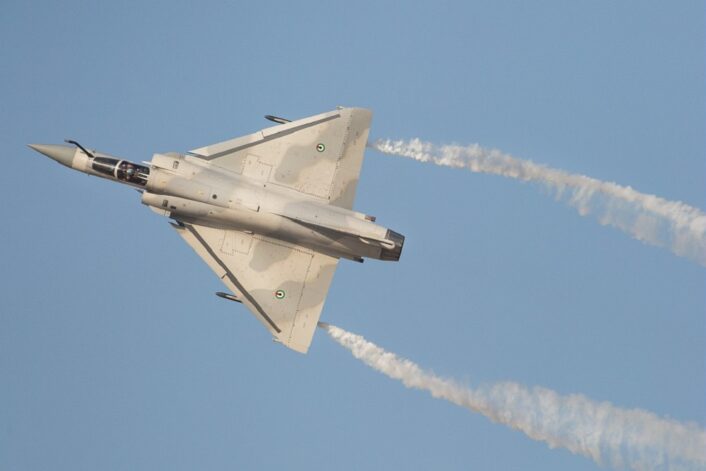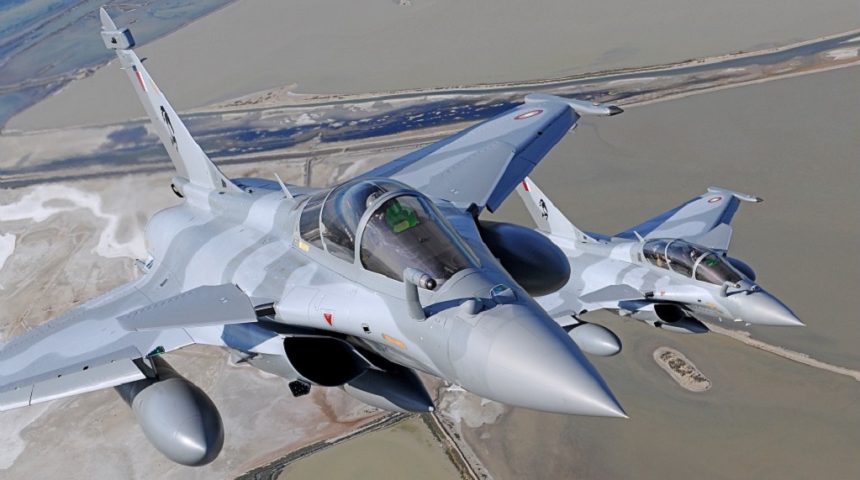The deal, which also includes Rafale’s weapons and 12 Caracal helicopters, is considered the largest contract ever signed for the export of French weapons.
France and the United Arab Emirates signed a historic deal for what has already been defined as the largest ever contract for the export of products of the French combat aviation industry. The deal was inked at the Dubai Expo 2020 on Dec. 3, 2021 at the presence of the French President Emmanuel Macron and Sheikh Mohammed ben Zayed Al Nahyane, Crown Prince of Abu Dhabi and Vice-Commander of the UAE Armed Forces, and includes three contracts, valued 17 Billion Euro (19.2B USD), for a total of 92 aircraft and related weapons.
The sale is divided as follows: a first contract, worth 14 billion Euro, covers the acquisition of 80 Dassault Rafale fighter jets, with a second 2B Euro contract for its weapons; the third contract, worth another billion, is related to the acquisition of 12 Airbus H225M Caracal helicopters, to be used for Combat Search And Rescue and anti-ship missions. With these contracts, the UAE will also become the largest export operator of the Rafale and the only operator, outside of France, to receive the latest Rafale F4 variant.
🇫🇷🤝🇦🇪 Suite à la signature du contrat de vente de 80 Rafale et 12 Caracal aux Émirats Arabes Unis, l’armée de l’Air et de l’Espace se félicite d’entretenir la collaboration étroite avec son partenaire historique. pic.twitter.com/ABTj5kKpS5
— Armée de l’Air et de l’Espace (@Armee_de_lair) December 3, 2021
Eric Trappier, CEO of Dassault Aviation, said: “The sale of 80 Rafale to the UAE Federation is a French success story: I am very proud and very happy as a result. I wish to thank the authorities of the Emirates for their renewed confidence in our aircraft. After the Mirage 5 and Mirage 2000, this Rafale contract consolidates the strategic relationship that binds our two countries and the satisfaction of the Emirates Air Force, a long-standing and demanding partner of our company.”
This deal has been in the works for more than a decade, as the UAE were the candidate to become the first export buyer of the Rafale in 2009, when the two governments were in talks for the sale of 60 fighter jets. The UAE are now the sixth export customer of the Rafale, joining Egypt, Qatar, India, Greece and Croatia and bringing the total export orders for the Rafale to 236 aircraft (including both new and second-hand aircraft).

The F4 upgrade has been divided in two parts, with the Rafale F4-1 standard already being tested since last April. The development of the Rafale F4 standard started in early 2019, when the contract for the new upgrade was notified by the Ministry of Defense soon after the certification of the F3-R standard. “This standard is based on four pillars: connectivity, engagement, availability, and the detection and fight against threats,” said the Minister of the Armed Forces in that occasion. “This F4 standard is a technological leap, an industrial leap, a strategic leap.”
According to the French Directorate General for Armaments, improving the connectivity of the Rafale and the associated networked employment methods, both in a national and allied context, is the primary goal of the F4 standard. The new standard will be the first step towards the networked multi-platform capabilities of the future Système de Combat Aérien Futur (SCAF).
The F4 standard will include upgrades of existing capabilities, like the Thales RBE2 AESA radar, the Spectra electronic warfare system, the OSF IRST, the Thales Talios targeting pod, the Reco NG reconnaissance pod and the communications suite. However, there will be also important new capabilities, like the Helmet Mounted Display, the MICA Next-Generation air-to-air missile and the new 1000 kg variant of the Safran AASM “Hammer” Precision-Guided Munition.
The HMD is a long-waited capability for the Rafale. According to reports, Qatar and India asked for an HMD on their aircraft, so the Elbit Targo II was integrated on the Rafale. France, however, chose to integrate the Scorpion, with a first test campaign carried out in Cazaux during March 2021. It is not known which of these two systems will be used by the UAE.
The stalled F-35 deal between U.S. and UAE, however, is not in danger because of the Rafale. This was also confirmed by Major General Ibrahim Nasser Al Alawi, commander of the UAE Air Force and Air Defence: “This deal is not considered as an alternative for the forthcoming F-35 deal, it is rather a complementary deal … as we develop our air force capabilities.”
As you may know already, the United States under then Trump administration agreed to sell 50 F-35s to the UAE, but the deal was slowed down amid concerns about the country’s relations with China and the use of Huawei 5G systems. The Biden administration confirmed this year that it will proceed with the sale during the ongoing consultation with UAE’s officials.
The first deliveries of the Rafale F4 to the UAE are planned for 2027. The aircraft will then start replacing the 56 Mirage 2000-9 jets, which are considered the most advanced variant of the delta-wing fighter. The Mirages are currently being upgraded so their service life can be extended up to 2030. According to reports, the upgrade program will include the replacement of the radar, mission computer, electronic warfare suites, cockpit displays and HMD system.









